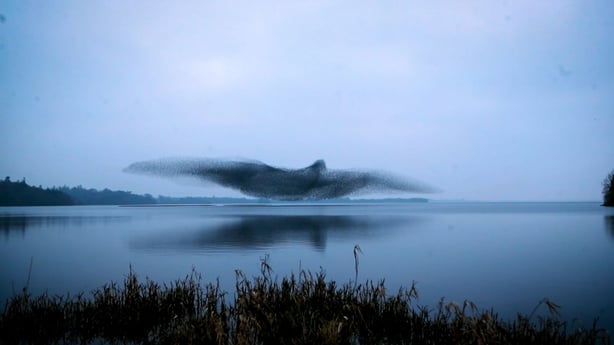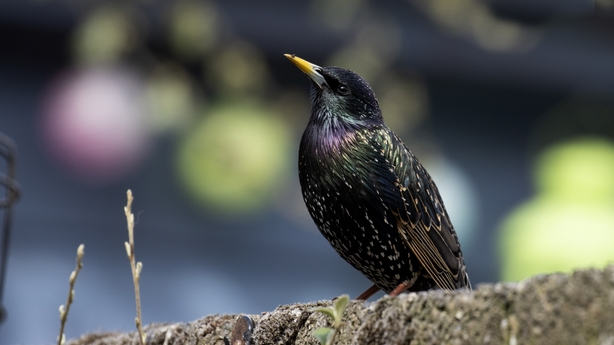You might have seen the RTÉ News report or the picture on the cover of a newspaper, so let's talk a bit more about one of nature's most amazing spectacles - murmurations.
Watch the amazing moment a murmuration of starlings took on the shape of a giant bird over Lough Ennell in Co Westmeath. Colin Hogg and James Crombie captured the moment after several months of "murmuration chasing".
Find out a lot more about these wonderful displays here with BirdWatch Ireland here...
Unfortunately, Starlings don't put on a show every time. They roost together in large numbers every night, but it's the aerial dance beforehand that we refer to as a 'murmuration’, so that bit isn’t always guaranteed.
These mesmerising movements across the sky, twisting and turning and creating all sorts of unimaginable shapes and patterns, have the effect of signalling to other Starlings to where they should roost, but it also makes it very difficult for predators to focus in on any one bird.
Read more about the science behind murmurations in this RTÉ Brainstorm article
These huge flocks regularly attract a who’s who of birds of prey – Peregrine Falcons, Merlins, Kestrels, Sparrowhawks and even Hen Harriers and Short-eared Owls! If there’s tens of thousands of Starlings present, then the birds of prey will fancy their chances of getting an evening meal before heading off to roost themselves.
From a Starlings point of view though, the more Starlings present then the lower the risk is to each individual Starling. If there’s 10,000 Starlings present, and let’s say two Peregrines and a Sparrowhawk all on the hunt, then the chances of any individual Starling being the one who gets caught is only 0.03% – pretty good odds!
BirdWatch Ireland would love to record as many as possible and you can share your sightings HERE!

How can they move like this?
Scientists have done a lot of work to figure out exactly how Starlings manage these aerial displays without crashing into each other. Instead, their movements appear coordinated, while seemingly moving in random directions and being able to react quickly and get out of the way of a stooping Peregrine or a Sparrowhawk whizzing by. Flocks split and merge, move left and right, up and down, high in the sky before suddenly dropping low over the ground, all without a single collision.
Thanks to the combined efforts of behavioural biologists, computer scientists and theoretical physicists, we now know that each Starling is reacting to the movements of the nearest seven or so neighbours in the flock. If every Starling is doing that, then you get the pulses and waves, and quick reactions that we're often treated to in these murmurations.
Where to go to spot murmuarations (if you are very lucky!)
Often they'll roost in reedbeds around lakes, in woods or forestry, and in some cases in Northern Ireland and the UK on bridges, large buildings and seaside piers. There are some well-known Starling roost locations used each year – for example Lough Ennell in Westmeath, near Nobber in Meath, Timoleague in Cork, Lackagh in Galway and Lough Ree in Roscommon.
These might be used for part or all of the winter, and the numbers can vary considerably week-to-week and month-to-month. Starlings are present all over Ireland during the winter, and they’ll travel tens of kilometres to roost at night – often 20km or more.
So it’s safe to assume that there are Starling roosts and murmurations all across the country every week – so we want your help to find them! They’re often easy to track down. Keep an eye on the sky around half an hour before sunset and you’ll see groups of tens, hundreds and maybe thousands of Starlings all flying in the same direction every evening.

Then think, what kind of habitat in that direction could they be heading for? Is there a big lake with a reedbed? Maybe there’s a substantial area of woodland? Maybe it’s some large urban building, or possibly even a rugged cliffside?
A bit of detective work later and you’ll track it down in no time! And once you do, let us know via the link here. We can’t stress enough how important it is to obey all government advice and restrictions concerning the pandemic and we don’t want anyone breaching those guidelines in search of Starlings. But, if you’re lucky enough to spot a murmuration near you then please let us know.
If you see any birds of prey at your local murmurations, be sure to include the details and species when you submit your record!
